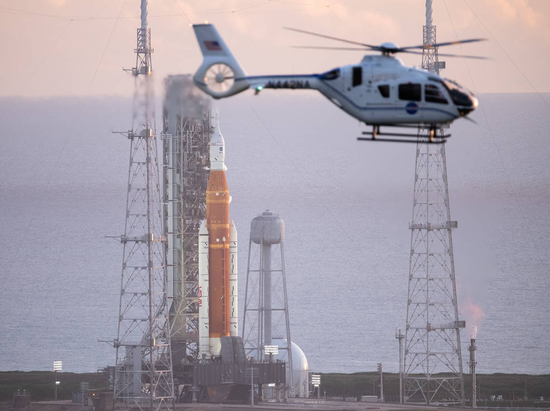your current location is:Home > TechnologyHomeTechnology
The launch of a new generation of lunar rockets was delayed due to a malfunction. Why did the United States "return to the moon" after half a century?
As the first step of the new U.S. lunar landing program, the much-watched "Artemis 1" unmanned flight test mission around the moon was delayed again due to technical failures.
According to CCTV news reports, on the morning of August 29, local time, NASA said that the new-generation "Space Launch System" (SLS) rocket that performed a flight test mission around the moon found a technical failure during ground inspection. The decision to delay the launch was made minutes before the launch window.
The launch team will decide the launch time in the next few days, and the next launch window will be at 12:48 on September 2 at the earliest.
It is reported that "Artemis" is a new moon landing plan announced by the US government in 2019. It was originally planned to send American astronauts to the moon again by 2024. Due to budget constraints and other reasons, NASA announced in November last year that the return of American astronauts to the moon may be delayed by a year than originally planned, with the earliest possible landing on the moon in 2025.
Before the astronauts land, NASA plans to conduct an uncrewed test flight around the moon code-named "Artemis 1" and a manned test flight around the moon, code-named "Artemis 2".
The last time humans left traces on the moon was the last lunar landing mission of the "Apollo program" in 1972. Some analysts believe that the United States restarted the lunar landing plan to further carry out scientific research on the moon and accumulate experience for future landings on Mars.
NASA originally planned to launch the latest generation of the moon landing rocket "Space Launch System" on the morning of August 29, local time, and send the "Orion" spacecraft it carried to the moon to execute the "Artemis 1" unmanned Lunar flight test mission.
According to the original plan, when the rocket flies to an altitude of 3,700 kilometers above the earth's surface, the "Orion" spacecraft will be separated from the upper stage of the rocket, ignite the thruster, and fly to the moon. After orbiting the moon in a large arc, it is expected that on October 10 Day returns to Earth, falling into the Pacific Ocean near San Diego, California.
Yesterday's launch, which captured the world's attention as the first step in the U.S. plan to return to the moon, was called off in the final minutes due to a technical glitch.
NASA said the rocket was still stable and nearly full of fuel, but a problem with one of the rocket's engine bleeds prevented the engine from reaching the temperature range suitable for launch. It was too late to fix the fault within the two-hour launch window. So the launch was called off. It is reported that the rocket has not had similar problems before.
The Space Launch System is the most powerful rocket system ever developed by NASA. The core part was built by Boeing and is the basis for the Artemis program. It is reported that the development of the space launch system has been carried out for nearly 10 years, the progress is more than 5 years later than the original plan, and the cost has repeatedly exceeded the budget. The cost of the space launch system has soared from an initial $7 billion to around $23 billion, according to estimates by The Planetary Society, an astronomy group. NASA estimates that a single launch of the Space Launch System costs more than $4 billion.
The entire Artemis program has also been plagued by delays and overspending. A total of $37 billion has been spent on projects related to the Space Launch System and the Orion spacecraft, according to Reuters. Former NASA deputy administrator Lori Garver told Reuters that even with repeated delays and additional budgets, U.S. astronauts may not be able to return to the moon by 2025.
 Image credit: NASA
Image credit: NASAIn 1969, the Apollo program put American astronauts on the moon for the first time. In 1972, Apollo 17 completed its last mission to the moon, and no man has landed on the moon since then.
Why is the United States spending huge sums of money to launch a new moon landing program again, and what is the difference between "Artemis" and "Apollo"?
First, the landing sites for the new moon landings are different. All six of the Apollo missions landed near the moon's "equator," but according to NASA's recently announced plans, 13 potential landing sites are located in the moon's south pole.
Wu Ji, chairman of the Chinese Space Science Society, wrote an analysis and pointed out that there are some permanently dark craters at the south pole of the moon that cannot be illuminated by sunlight all the year round. After radar echo detection, scientists determined that there may be water ice at the bottom of these craters. If the scientists' inferences are confirmed, these water ices could not only support the water demand of future human lunar bases, but also extract hydrogen and oxygen through electrolysis of water to fuel rocket engines.
In addition, scientific interest in the Moon remains strong. Scientists believe that because the moon never had an atmosphere and flowing water, the lunar surface retains what it looked like when it formed billions of years ago, providing "fossils" for studying the evolution of the solar system.
In addition to conducting new scientific research on the moon, the new lunar landing plan will also accumulate experience for humans to land on Mars.
According to NASA's plan, the "Artemis" plan is not simply to complete the manned moon landing, but it is intended to allow humans to permanently settle on and around the moon. The complete "Artemis" program includes six major components: the SLS rocket, the "Orion" manned spacecraft, the exploration ground system, the "Gateway" lunar orbital space station, the manned lunar landing system and the "Artemis Base Camp". "Moon base.
Among them, the "Gateway" lunar orbital space station will not only serve as a transfer station for human landings on the moon, but also serve for future landings on Mars. However, the development progress of the "Gateway" space station is far behind expectations. Lovero, NASA's deputy administrator for human spaceflight, said in 2020 that the "Gateway" space station may not participate in the upcoming manned lunar landing program.
Previous:Sources say the EU has abandoned the appeal: Qualcomm finally won a $1 billion antitrust appeal
Next:What might Apple announce at its September 'Far Out' event?
related articles
Article Comments (0)
- This article has not received comments yet, hurry up and grab the first frame~













